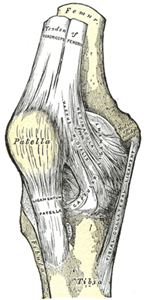 Tendons are connective tissues that join muscles to the bones. Gradually the tissues of the muscle become the tissues of the tendon, which in turn gradually evolve into bone tissue. Once again we see that the body is not segregated, as many medical models imply. Such separation of parts of the body is just a convenience for learning, not reality.
Tendons are connective tissues that join muscles to the bones. Gradually the tissues of the muscle become the tissues of the tendon, which in turn gradually evolve into bone tissue. Once again we see that the body is not segregated, as many medical models imply. Such separation of parts of the body is just a convenience for learning, not reality.
It is the muscles’ job to provide the varying degrees of tension that allows precise movements to occur. The tendon does not change its shape when the muscle does. If the tendon were to change shape or stretch, it would affect the precise control the body has over desired movements. We rely upon the nervous system to control the muscular contraction to create movement. The only nervous system interaction with the tendon comes from sensors in the tendon that tell us when a stretch has become too strong. When this happens, cells, called the “Golgi tendon organs,” embedded in the tendon, signal the nervous system to quickly and suddenly relax the muscle. [1] A stretch of four percent in a tendon is considered the limit to its elasticity. Forces that would stretch the tendon farther than four percent could permanently damage the tendon.
Ligaments
 Ligaments are similar in construction to tendons but their function is to bind bones together, usually supporting a joint. Unlike tendons, ligaments come in a variety of shapes: they can be chords, sheets, or bands. Where tendons are generally white in appearance, ligaments can be darker due to their mixture of elastic and finer fibers. Ligaments can be pliant and flexible in the directions where they are not binding the body. [2] These qualities make ligaments ideal for protecting joints, which may move in a variety of ways. Ligaments are tough, strong, pliable, and yet inelastic. The illiotibial band running down the outside of your thigh, for example, is strong enough to support the weight of a car without snapping!
Ligaments are similar in construction to tendons but their function is to bind bones together, usually supporting a joint. Unlike tendons, ligaments come in a variety of shapes: they can be chords, sheets, or bands. Where tendons are generally white in appearance, ligaments can be darker due to their mixture of elastic and finer fibers. Ligaments can be pliant and flexible in the directions where they are not binding the body. [2] These qualities make ligaments ideal for protecting joints, which may move in a variety of ways. Ligaments are tough, strong, pliable, and yet inelastic. The illiotibial band running down the outside of your thigh, for example, is strong enough to support the weight of a car without snapping!
Not all ligaments are rigid along their lengths; some ligaments have a higher proportion of elastic fibers (elastin) than collagen. Elastin [3] gives us an ability to stretch tissues just like muscles do. They distribute stress instead of maintaining it in one place. The ligaments in the vertebral column of our lumbar spine and in our necks are especially elastic in this way. In fact, the ligaments in the lumbar spine are the most flexible ligaments in our body. When elastin fibers age they become mineralized and cross-linked with other fibers – they become stiffer.
The tendons and ligaments are quite dry compared to the muscle or other tissues of the body. They generally contain only one to three percent “glycosaminoglycans,” the molecules that hydrate our tissues. [4]
- — This is noticeable at the end of an arm wrestling match when the losing competitor collapses suddenly his body is reacting to a stretch signal that is telling him he is close to damaging himself and thus the effort ceases.
- — Imagine a credit card – it is pliant and flexible, yet it will resist being stretched longer or wider.
- — Which is produced by our fibroblasts, as explained in our next section.
- — See the section Ground Substances for more details on glycosaminoglycans.
(Next: Plastic versus Elastic )
